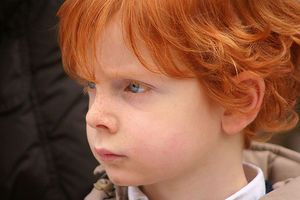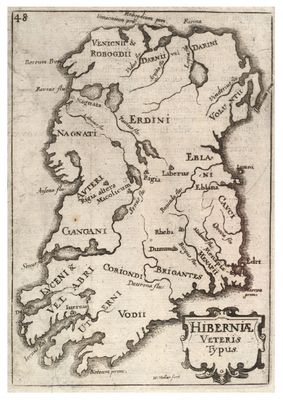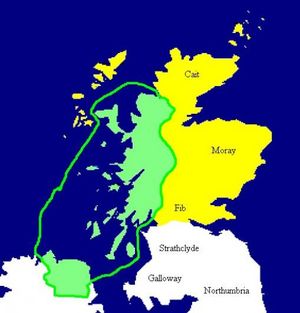
Posted on 01/11/2014 6:13:55 AM PST by NYer

The blood in Irish veins is Celtic, right? Well, not exactly. Although the history many Irish people were taught at school is the history of the Irish as a Celtic race, the truth is much more complicated, and much more interesting than that ...
Research done into the DNA of Irish males has shown that the old Anthropological attempts to define 'Irish' have been misguided. As late as the 1950s researchers were busy collecting data among Irish people such as hair colour and height, in order to categorise them as a 'race' and define them as different to the British. In fact British and Irish people are closely related in their ancestry.
Research into Irish DNA and ancestry has revealed close links with Scotland stretching back to before the Ulster Planation of the early 1600s. But the closest relatives to the Irish in DNA terms are actually from somewhere else entirely!

Medieval map of Ireland, showing Irish tribes. Irish origin myths confirmed by modern scientific evidence
The earliest settlers came to Ireland around 10,000 years ago, in Stone Age times. There are still remnants of their presence scatter across the island. Mountsandel in Coleraine in the North of Ireland is the oldest known site of settlement in Ireland - remains of woven huts, stone tools and food such as berries and hazelnuts were discovered at the site in 1972.
But where did the early Irish come from? For a long time the myth of Irish history has been that the Irish are Celts. Many people still refer to Irish, Scottish and Welsh as Celtic culture - and the assumtion has been that they were Celts who migrated from central Europe around 500BCE. Keltoi was the name given by the Ancient Greeks to a 'barbaric' (in their eyes) people who lived to the north of them in central Europe. While early Irish art shows some similarities of style to central European art of the Keltoi, historians have also recognised many significant differences between the two cultures.
The latest research into Irish DNA has confirmed that the early inhabitants of Ireland were not directly descended from the Keltoi of central Europe. In fact the closest genetic relatives of the Irish in Europe are to be found in the north of Spain in the region known as the Basque Country. These same ancestors are shared to an extent with the people of Britain - especially the Scottish.
DNA testing through the male Y chromosome has shown that Irish males have the highest incidence of the haplogroup 1 gene in Europe. While other parts of Europe have integrated contiuous waves of new settlers from Asia, Ireland's remote geographical position has meant that the Irish gene-pool has been less susceptible to change. The same genes have been passed down from parents to children for thousands of years.
This is mirrored in genetic studies which have compared DNA analysis with Irish surnames. Many surnames in Irish are Gaelic surnames, suggesting that the holder of the surname is a descendant of people who lived in Ireland long before the English conquests of the Middle Ages. Men with Gaelic surnames, showed the highest incidences of Haplogroup 1 (or Rb1) gene. This means that those Irish whose ancestors pre-date English conquest of the island are direct descendants of early stone age settlers who migrated from Spain.

The Kingdom of Dalriada c 500 AD is marked in green. Pictish areas marked yellow. Irish and British DNA : a comparison
Irish origin myths confirmed by modern scientific evidence
One of the oldest texts composed in Ireland is the Leabhar Gabhla, the Book of Invasions. It tells a semi-mythical history of the waves of people who settled in Ireland in earliest time. It says the first settlers to arrive in Ireland were a small dark race called the Fir Bolg, followed by a magical super-race called the Tuatha de Danaan (the people of the goddess Dana).
Most interestingly, the book says that the group which then came to Ireland and fully established itself as rulers of the island were the Milesians - the sons of Mil, the soldier from Spain. Modern DNA research has actually confirmed that the Irish are close genetic relatives of the people of northern Spain.
While it might seem strange that Ireland was populated from Spain rather than Britain or France, it is worth remembering that in ancient times the sea was one of the fastest and easiest ways to travel. When the land was covered in thick forest, coastal settlements were common and people travelled around the seaboard of Europe quite freely.
I live in Northern Ireland and in this small country the differences between the Irish and the British can still seem very important. Blood has been spilt over the question of national identity.
However, the lastest research into both British and Irish DNA suggests that people on the two islands have much genetically in common. Males in both islands have a strong predominance of Haplogroup 1 gene, meaning that most of us in the British Isles are descended from the same Spanish stone age settlers.
The main difference is the degree to which later migrations of people to the islands affected the population's DNA. Parts of Ireland (most notably the western seaboard) have been almost untouched by outside genetic influence since hunter-gatherer times. Men there with traditional Irish surnames have the highest incidence of the Haplogroup 1 gene - over 99%.
At the same time London, for example, has been a mutli-ethnic city for hundreds of years. Furthermore, England has seen more arrivals of new people from Europe - Anglo-Saxons and Normans - than Ireland. Therefore while the earliest English ancestors were very similar in DNA and culture to the tribes of Ireland, later arrivals to England have created more diversity between the two groups.
Irish and Scottish people share very similar DNA. The obvious similarities of culture, pale skin, tendancy to red hair have historically been prescribed to the two people's sharing a common celtic ancestry. Actually it now seems much more likely that the similarity results from the movement of people from the north of Ireland into Scotland in the centuries 400 - 800 AD. At this time the kingdom of Dalriada, based near Ballymoney in County Antrim extended far into Scotland. The Irish invaders brought Gaelic language and culture, and they also brought their genes.
Irish Characteristics and DNA
The MC1R gene has been identified by researchers as the gene responsible for red hair as well as the accompanying fair skin and tendency towards freckles. According to recent research, genes for red hair first appeared in human beings about 40,000 to 50,000 years ago.
These genes were then brought to the British Isles by the original settlers, men and women who would have been relatively tall, with little body fat, athletic, fair-skinned and who would have had red hair. So red-heads may well be descended from the earliest ancestors of the Irish and British.
A spoof (and very funny) exploration into the characteristics of all Irish-blooded males can be read at this link: www.irishtimes.com/newspaper/weekend. Identified genes include IMG or the Irish Mother Gene and the GK (MF) S Gene Kelly-Michael-Flately-Syndrome which explains the inability of the Irish man to move his hips while dancing!
The early inhabitants were Britons.
Woman: Who are the Britons?
King Arthur: Well, we all are. We are all Britons. And I am your king.
Woman: I didn't know we had a king. I thought we were an autonomous collective.
You’re foolin’ yourself! We’re living in a dictatorship. A self-perpetuating autocracy in which the working class . . .
Help! Help! I’m being repressed!
Did he look like someone from Latin America or from Spain? The article is theorizing that original Irish ancestors came from Spain, not Latin America.
Bloody peasant.
The Milesians are of the red thread of Zerah and settled Spain and Ireland when they had to flee due to the birth controversy. At the Babylonian captivity the tender twig merged with the red thread to continue the line of David's reign on David's throne, aided by Jeremiah and Baruch. Yes, northern Spain and Ireland should be related, as the tribe of Dan and the tribe of Judah are related.
It's nice to see that DNA studies are confirming what bible studiers have known for hundreds of years.
My Norwegian grandmother claimed that our family was descended from Eric the Red, something about our “family crest” and stories passed down on her father’s side, but I take that with a bit of a grain of salt as I bet a lot of Norwegians claim this.
I am interested in getting one of those 23andme DNA kits; I think it would be interesting, perhaps even clarify some of my ancestry.
As far as the British Isles and the Scandinavian influence, both on culture, language and genetics, don’t forget that the Vikings did not just conduct pillaging raids but they also settled large areas of Brittan, i.e. the Daneland. Then they, the Anglo Saxons who were Germanic, were invaded by the Normans…. the Normans being decedents of Norsemen who settled in the north of France, the area known as Normandy.
Not unusual. So did Indians, when harvesting walnuts, in North America.
“Did he look like someone from Latin America or from Spain?”
Spain,that’s why I posted “Hispanic”.
.
Your right, when I looked it up I only saw the second definition.
People from Spain are not particularly dark-skinned, unless they’re from Southern Spain, where there is more of a North African influence.
The Irish would have been descended from a group located in Northern Spain, where many people have very black hair, very fair skin, and either blue or black eyes. This is basically the look that the “black Irish” have.
Things like hazel eyes and even red hair are generally the result of a mixture of a blond group with a black-haired group, such as the mixture of the blond Vikings with the original black-haired Irish.
There are virtually no red-heads in Northern Spain unless they are the product of modern marriages.
In any case, Latin Americans are an entirely different mixture. They are European Spaniards with a Native America admixture, combined with later influences of other European groups, particularly Germans and to a lesser extent, the English and the Italians. Some are more or less Indian than others. Argentinians, for example, have very little Indian blood and pride themselves on being mostly Italian (probably why their country looks so good but is so dysfunctional).
As for the Spaniards, a lot of the ordinary people who did much of the settlement came from Andalusia (Southern Spain), although most of the expedition leaders and officers came from Northern Spain, so there is a wide range of coloring and features.
23andMe is basically a data collection thing. When they send you the kit (for which you have paid something), they then ask you a million genetic research questions - about your family, your body, your health, etc. - before you can even go ahead.
Also, if you’re a woman, you can’t get a very clear reading on the genetic background since you’re missing part of it. If you have a brother, have him do it.
Basically, I’d say that if you want to do it, it will give you something although not very much if you’re a woman, but refuse to fill out their forms unless you really like that sort of thing.

Parts of Ireland (most notably the western seaboard) have been almost untouched by outside genetic influence since hunter-gatherer times.
That's where three of my bloodlines are from. May account for the stubbornness. :)
Real Irish grow actual beards. At least that's not green beer there.
From the FRchives:
Genetic Survey Reveals Hidden Celts Of England
http://www.freerepublic.com/focus/fr/584960/posts
Split Between English and Scots Older Than Thought
http://www.freerepublic.com/focus/news/1115744/posts
‘Apartheid’ slashed Celtic genes in early England
http://www.freerepublic.com/focus/chat/1668298/posts
Irish, Scots And Welsh Not Celtic - Scientist
http://www.freerepublic.com/focus/news/1211427/posts
Our Celtic Roots Lie In Spain And Portugal
http://www.freerepublic.com/focus/news/2011978/posts
English and Welsh are races apart DNA
http://www.freerepublic.com/focus/news/2535539/posts
Gene Study Shows Ties Long Veiled in Europe [repost]
http://www.freerepublic.com/focus/chat/2536288/posts
CHRIST in BRITAIN
http://www.greatdreams.com/jesus2.htm
>> Argentinians, for example, have very little Indian blood and pride themselves on being mostly Italian <<
It’s often said of the Argentinos that they are Italians who speak Spanish — and who pretend they are English!
(They take afternoon tea at the polo club, etc.)
Disclaimer: Opinions posted on Free Republic are those of the individual posters and do not necessarily represent the opinion of Free Republic or its management. All materials posted herein are protected by copyright law and the exemption for fair use of copyrighted works.